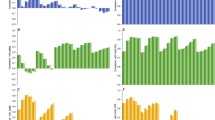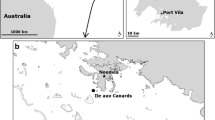Abstract
Understanding the energy expenditure of top predators is important because a collapse in them could trigger trophic cascades through ecosystems. One such top predator, Japanese sea bass Lateolabrax japonicus, helps to balance the structure of the coastal marine ecosystem through predation. In this study, accelerometry was applied to the Japanese sea bass to estimate its energy expenditure under natural conditions. We attached accelerometers to five wild fish and measured metabolic rates such as the oxygen consumption rate (\({\dot{\text{V}}\text{O}}_{ 2}\), mg O2 kg−1 min−1) using a swim tunnel. Body beat frequency (BBF) was measured using the accelerometer. The BBF was correlated with the tail beat frequency (TBF) by analyzing video recordings. \({\dot{\text{V}}\text{O}}_{ 2}\) was related to swimming speed (U), TBF, and BBF. We estimated the standard (45.9 kJ kg−1 day−1) and active (124.0 kJ kg−1 day−1) metabolic rates when fish were not swimming and when they were swimming at the optimum swimming speed, respectively. The energy required to compensate for the above metabolic rates are between 83.3 and 275.6 kJ kg−1 day−1 using an assimilation efficiency of 0.7 and assuming that the growth rate is zero. These costs were comparable to consuming one or two prey fish per day (e.g., Japanese sardine: mean total length 155 ± SD 6 mm).








Similar content being viewed by others
References
Baum JK, Worm B (2009) Cascading top-down effects of changing oceanic predator abundances. J Anim Ecol 78:699–714
Frank KT, Petrie B, Choi JS, Leggett WC (2005) Trophic cascades in a formerly cod-dominated ecosystem. Science 308:1621–1623
Estes JA, Tinker MT, Williams TM, Doak DF (1998) Killer whale predation on sea otters linking oceanic and nearshore ecosystems. Science 282:473–476
Videler JJ (1993) Fish swimming. Chapman and Hall, London
Claireaux G, Couturier C, Groison AL (2006) Effect of temperature on maximum swimming speed and cost of transport in juvenile European sea bass (Dicentrarchus labrax). J Exp Biol 209:3420–3428
Beamish FWH (1978) Swimming capacity. In: Hoar W, Randall D (eds) Fish physiology. VII: Locomotion. Academic, London, pp 101–187
Brett JR (1964) The respiratory metabolism and swimming performance of young sockeye salmon. J Fish Res Board Canada 21:1183–1226
Brett JR (1965) The relation of size to rate of oxygen consumption and sustained swimming speed of sockeye salmon (Oncorhynchus nerka). J Fish Res Board Canada 22:1491–1501
Van den Thillart G, van Ginneken V, Körner F, Heijimans R, Van der Linden R, Gluvers A (2004) Endurance swimming of European eel. J Fish Biol 65:312–318
Steinhausen MF, Steffensen JF, Andersen NG (2005) Tail beat frequency as a predictor of swimming speed and oxygen consumption of saithe (Pollachius virens) and whiting (Merlangius merlangus) during forced swimming. Mar Biol 148:197–204
Clark TD, Sandblom E, Hinch SG, Paterson DA, Frappell PB, Farrel AP (2010) Simultaneous biologging of heart rate and acceleration, and their relationships with energy expenditure in free-swimming sockeye salmon (Oncorhynchus nerka). J Comp Physiol B 180:673–684
Wilson RP, White CR, Quintana F, Halsey LG, Liebsch N, Martin GR, Butler PJ (2006) Moving towards acceleration for estimates of activity-specific metabolic rate in free-living animals: the case of the cormorant. J Anim Ecol 75:1081–1090
Halsey LG, Green JA, Wilson RP, Frappell PB (2009) Accelerometry to estimate energy expenditure during activity: best practice with data loggers. Physiol Biochem Zool 82:396–404
Gleiss AC, Dale JJ, Holland KN, Wilson RP (2010) Accelerating estimates of activity-specific metabolic rate in fishes: testing the applicability of acceleration data-loggers. J Exp Mar Bio Ecol 385:85–91
Qasem L, Cardew A, Wilson A, Griffiths I, Halsey LG, Shepard ELC, Gleiss AC, Wilson RP (2012) Tri-axial dynamic acceleration as a proxy for animal energy expenditure; should we be summing values or calculating the vector? PLoS One 7:e31187. doi:10.1371/journal.pone.0031187
Wright S, Metcalfe J, Hetherington S, Wilson R (2014) Estimating activity-specific energy expenditure in a teleost fish, using accelerometer loggers. Mar Ecol Prog Ser 496:19–32
Tanaka H, Takagi Y, Naito Y (2001) Swimming speeds and buoyancy compensation of migrating adult chum salmon Oncorhynchus keta revealed by speed/depth/acceleration data logger. J Exp Biol 204:3895–3904
Kawabe R, Kawano T, Nakano N, Yamashita N, Hiraishi T, Naito Y (2003) Simultaneous measurement of swimming speed and tail beat activity of free-swimming rainbow trout Oncorhynchus mykiss using an acceleration data-logger. Fish Sci 69:959–965
Lowe CG (2002) Bioenergetics of free-ranging juvenile scalloped hammerhead sharks (Sphyrna lewini) in Kāne’ohe Bay, Ō’ahu, HI. J Exp Mar Bio Ecol 278:141–156
Murchie KJ, Cooke SJ, Danylchuk AJ, Suski CD (2011) Estimates of field activity and metabolic rates of bonefish (Albula vulpes) in coastal marine habitats using acoustic tri-axial accelerometer transmitters and intermittent-flow respirometry. J Exp Mar Bio Ecol 396:147–155
Secor DH, Ohta T, Nakayama K, Tanaka M (1998) Use of otolith microanalysis to determine estuarine migrations of Japanese sea bass Lateolabrax japonicus distributed in Ariake Sea. Fish Sci 64:740–743
Tanaka M, Kinoshita I (2002) Temperate bass and biodiversity—new perspective for fisheries biology. Koseisha-koseikaku, Tokyo (in Japanese)
Miyahara K, Ohtani T, Shimamoto N (1995) Feeding habitats of Japanese sea bass Leteolabrax japonicus in Harima-nada. Hyogo Suishi Kenpo 32:1–8 (in Japanese with English abstract)
Fujita S, Kinoshita I, Takahashi I, Azuma K (1988) Seasonal occurrence and food habits of larvae and juveniles of two temperate basses in the Shimanto estuary, Japan. Jpn J Ichthyol 35:5–10
Hatanaka M, Sekino K (1962) Ecological studies on the Japanese sea bass, Lateolabrax japonicus. I. feeding habit. Nippon Suisan Gakkaishi 28:851–856 (in Japanese with English abstract)
Kato M, Ikegami N (2004) Recent trend of stock and distribution of fishing ground of small scale trawl for Japanese sea bass Lateolabrax japonicus (Cuvier) in Tokyo bay. Bull Chiba Pref Fish Res Cen 3:17–30 (in Japanese)
Watanabe T (1965) Ecological distribution of eggs of common sea bass, Lateolabrax japonicus (Cuvier) in Tokyo bay. Nippon Suisan Gakkaishi 31:585–590 (in Japanese with English abstract)
Fuji T, Kasai A, Suzuki KW, Ueno M, Yamashita Y (2011) Migration ecology of juvenile temperate seabass Lateolabrax japonicus: a carbon stable-isotope approach. J Fish Biol 78:2010–2025
Hatanaka M, Sekino K (1962) Ecological studies on the Japanese sea bass. Lateolabrax japonicus. II. Growth. Nippon Suisan Gakkaishi 28:857–861 (in Japanese with English abstract)
Hatanaka M, Sekino K (1962) Ecological studies on the Japanese sea bass, Lateolabrax japonicus. III. Efficiency of production. Nippon Suisan Gakkaishi 28:949–954 (in Japanese with English abstract)
Sakamoto KQ, Sato K, Ishizuka M, Watanuki Y, Takahashi A, Daunt F, Wanless S (2009) Can ethograms be automatically generated using body acceleration data from free-ranging birds? PLoS One 4:e5379. doi:10.1371/journal.pone.0005379
Herskin J, Steffensen JF (1998) Energy savings in sea bass swimming in a school: measurements of tail beat frequency and oxygen consumption at different swimming speeds. J Fish Biol 53:366–376
Yasuda T, Komeyama K, Kato K, Mitsunaga Y (2012) Use of acceleration loggers in aquaculture to determine net-cage use and field metabolic rates in red sea bream Pagrus major. Fish Sci 78:229–235
Clarke A, Johnston NM (1999) Scaling of metabolic rate with body mass and temperature in teleost fish. J Anim Ecol 68:893–905
Lindsey CC (1978) Form, function, and locomotory habits in fish. In: Hoar WS, Randall DJ (eds) Fish physiology. VII: Locomotion. Academic, London, pp 1–100
Beamish FWH (1970) Oxygen consumption of largemouth bass, Micropterus salmoides, in relation to swimming speed and temperature. Can J Zool 48:1221–1228
Palstra A, Van Ginneken V, Van den Thillart G (2008) Cost of transport and optimal swimming speed in farmed and wild European silver eels (Anguilla anguilla). Comp Biochem Physiol A Mol Integr Physiol 151:37–44
Elliott JM (1976) The energetics of feeding, metabolism and growth of brown trout (Salmo trutta L.) in relation to body weight, water temperature and ration size. J Animal Ecol 45:923–948
Tytler P, Calow P (1985) Fish energetics: new perspectives. Johns Hopkins University Press, Baltimore
Elliott JM, Davison W (1975) Energy equivalents of oxygen consumption in animal energetics. Oecologia 19:195–201
Beamish FWH (1974) Apparent specific dynamic action of largemouth bass, Micropterus salmoides. J Fish Res Board Canada 31:1763–1769
Boisclair D, Leggett WC (1989) The importance of activity in bioenergetics models applied to actively foraging fishes. Can J Fish Aquat Sci 46:1859–1867
Ney JJ (1993) Bioenergetics modeling today: growing pains on the cutting edge. Trans Am Fish Soc 122:736–748
Acknowledgments
We sincerely thank G. Van den Thillart for providing the Atmosphere and Ocean Research Institute, The University of Tokyo with the swim tunnel. We thank K. Mizushima, T. Niizawa, and M. Kaku for collecting fish, and especially thank T. Takatsu and H. Shinomiya for shipping. We also thank R. Manabe for his support during the laboratory work. We are grateful for the comments of A.A. Robson, which greatly improved the manuscript. This study was supported by the Ocean Policy Research Foundation, Bio-logging Science, The University of Tokyo, and the Japan Science Society (to TM) as well as the Japan Society for the Promotion of Science (24241001 and 25660152 to KS). We are grateful for the comments of three anonymous referees which greatly improved the manuscript.
Author information
Authors and Affiliations
Corresponding author
Rights and permissions
About this article
Cite this article
Mori, T., Miyata, N., Aoyama, J. et al. Estimation of metabolic rate from activity measured by recorders deployed on Japanese sea bass Lateolabrax japonicus . Fish Sci 81, 871–882 (2015). https://doi.org/10.1007/s12562-015-0910-7
Received:
Accepted:
Published:
Issue Date:
DOI: https://doi.org/10.1007/s12562-015-0910-7




